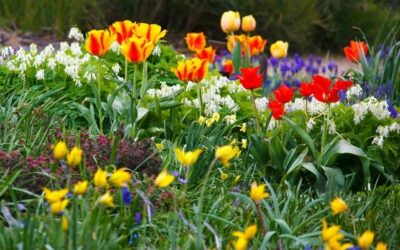Trees & Ornamentals Information

Fall Seeding Your Lawn
FALL SEEDING YOUR LAWN:
The 4 Crucial Components to Seeding
STEP 1: Buy the Best Seed
Not all grass seed is the same, you want to buy from a supplier who follows the National Turfgrass Evaluation Program (NTEP) research trials. NTEP is an independent group of greens industry professionals who grow, evaluate and compare the best seed varieties from competing seed manufacturers and breeders. The NTEP ratings measure the quality of grass seed varieties for superior green grass color, disease & insect resistance and drought tolerance. At Organic Turf Trade, we handpick the top competing seed varieties in the NTEP research trials for our Tri-Variety Tall Fescue Blend, 90/10 Tall Fescue Kentucky Bluegrass Mix and more! Tall Fescue, the best seed option in New Jersey, is known for its color, low maintenance and exceptional drought & temperature tolerance. Kentucky Bluegrass is highly desirable, provides beautiful color and will fill in bare spots which is great for active yards that see a lot of wear and tear from children and pets.
STEP 2: Soil Prep
It is important for the soil to be prepped before seeding your yard. You don’t see a farmer just throw their seed on their plot and hope it produces an abundance of crops. Farmers prepare their soil before seeding to maximize efficiency and production. Just like a farmer’s crop, grass seed benefits from soil intervention. The current state of your yard will determine how you should treat your soil before seeding. Most likely, you already have an existing lawn and you are looking to overseed to thicken it up. Existing lawns should first be removed of any large debris such as sticks and stones and then mowed as short as possible with the clippings collected. If you are establishing a new lawn, you should remove large debris and then loosen the top 2-3 inches of the soil. You should always level any areas in your yard that concentrate water as standing water will suffocate new grass plants.
STEP 3: Application and Timetables
Just like Soil Preparation, the application rate at which seed should be spread will be dependent upon the condition of your yard. If you are planning to seed an existing lawn, we recommend speaking with a professional beforehand to prevent over-seeding. Seeding to establish a new lawn will require a rate of 10lbs / 1,000 square feet and it is highly recommended to protect the seed by covering the ground with straw mats. After spreading your grass seed, it is important to provide proper nutrients by using a starter fertilizer with a seed stimulant like our 8-14-1 w/ Bio-Fusion to help the grass establish faster. For uniform growth, spread the seed using a broadcast-spreader for large areas and a hand-held spreader for smaller areas. The best time to seed is in the Fall between late September and early October. If you plan to seed in the Spring, speak with a professional as the proper time for seeding is narrow, weather dependent and can be easily missed.
STEP 4: Water for Success
Water is a basic necessity for all of life, and that includes grass. Watering your newly spread seed provides good soil contact, encourages germination and aids in root development for the new plant. We professionally recommend watering frequently, if not every day, for the first month. Water once in the morning and again in the evening when temperatures are cooler. Overwatering will produce shallow root growth, which in turn will produce a weak lawn. Speak with a professional to determine the right amount of water your lawn will need for proper root development. After the first month, or when your new, bright green grass blades reach mowing height, you should gradually recede the watering schedule to 3 days per week. You can directly improve root development and nutrient intake for your new lawn by applying our Organic Precise Bio-Fusion + Myco 2lb package, a beneficial organic plant food and root growth product.
More Information for Caring for your Trees and Ornamentals
Gardening Guru Guidelines for NJ Friendly Gardens
Vibrant, beautiful flowers make us all smile and improve our mental and physical well-being. And bonus, they help the environment too. Flowers are a source of food for many creatures while other plants act as natural insecticides that repel unwanted insects that can...
Mulching Trees and Gardens – Magic or Mess?
Mulch can reduce weeds, keep roots cool in summer, increase soil health, help you conserve water, maintain adequate soil moisture…and it can increase the visual appeal of trees, shrubs, and flower beds. BUT only if done right. What should you consider when choosing...
C’mon, Let’s Get Our Hands Dirty
Com’on let’s get our hands dirty. A few days of warm weather and we get excited to plant our spring flowers. Make it a family affair, get outside and work together to prep your gardens for months of beautiful flowers. Start by removing leaves and other debris...
Water Conservation
Water is crucial to almost every aspect of life from drinking, bathing, and food preparation to healthy yards and trees as well as the survival of fish and wildlife. Your water conservation efforts are important, at work and home, inside and out. Find out how Organic...
Trees Are Critical to The Environment and Deserve Lovin’ Too
No, it is not Arbor Day yet, but your trees had a tough winter too. They need proper care and nutrients to thrive and survive. Trees are homes for birds and small animals, a place to build your fort and hang your hammock. They also produce Summer shade, winter warmth,...
Spring in New Jersey
What images does a spring day conjure up in your mind? Bright yellow daffodils swaying in the breeze, Rhodies beckoning to bloom, the vibrant blues of the Hydrangea, quiet walks on windswept beaches, or soaking rains that quench the thirst of vibrant landscapes. Early...
CONNECT
Get in Touch
Contact:
(856) 478-6704
yardcare@organicturftrade.com






